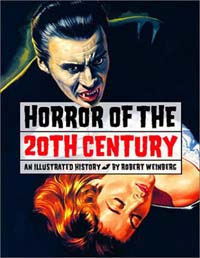|
|
|
BOOK REVIEW EXTRA The art of horror October 17, 2000 By Franklin Harris HORROR OF THE 20TH CENTURY: An Illustrated History by Robert Weinberg. Collectors Press: Portland, Ore., 256 pages, $60, hardcover When people think of horror, they usually think of gothic novels or slasher movies, but horror extends to art as well. Painters like Francisco Josť de Goya Lucientes, Salvator Rosa and Henry Fuseli created nightmarish dreamscapes that have influenced novelists, poets and filmmakers. In this century, however, it has been the other way around, with art serving to promote the books and movies it once inspired. That doesn't, however, make modern horror art any less worthwhile. Not necessarily, anyway.
Like its predecessors, "Horror of the 20th Century" isn't so much an illustrated history as it is a history of illustration. As is necessary, the author, Robert Weinberg, begins with pre-20th Century horror, touching upon the gothic stories of Mary Shelley, Matthew Lewis and Edgar Allan Poe. Weinberg illustrated this early section mostly with uninspiring book covers from paperback reprints. This hints at problems to come. In the book's latter chapters, Weinberg fills page after page with soulless artwork, ranging from cookie-cutter paperback covers to the box art from video releases. It isn't Weinberg's fault that the vast majority of recent horror art is the paint-by-numbers product of Hollywood and New York marketing departments, but he lazily chooses bad examples when better ones exist. Why print the art from a videotape box when you can print the movie poster? A more glaring example, found in the chapter on horror comics, is that instead of showcasing the original covers of EC Comics' horror titles from the 1950s, Weinberg features the covers of '90s reprint editions. There isn't much difference between the reprints and the originals, but for a $60 volume, readers deserve the genuine articles, simply as a matter of courtesy. Fortunately, the chapter on pulp magazines somewhat mitigates these glaring flaws. There is some overlap between the pulp magazine covers printed here and the ones featured in the earlier "Pulp Culture: The Art of Fiction Magazines" by Frank M. Lawrence and Lawrence Davidson. But, for the most part, "Horror of the 20th Century" follows the art form to new extremes. Pulp fiction magazine covers aren't to everyone's taste. In these politically correct times, they are probably sexist, blasphemous or worse, filled with barely dressed women facing unspeakable perils at the hands of ogre-like criminals and mad scientists. Joe Lieberman and William Bennett would not approve. But these racy lurid covers, for magazines like Weird Tales, Terror Tales Dime Mystery Magazine and Horror Stories, are magnificent, sexy, lurid works of art, created by forgotten heroes like John Howett, John Drew and Margaret Brundage. Another plus is an early chapter on horror films. The posters Universal and Hammer studios used to promote their Frankenstein, Dracula and other horror films make more recent horror movie posters seem tame. Today's movie posters are certainly less sensational. Unlike the earlier books in the series, which are solid from cover-to-cover, "Horror of the 20th Century" is a mixed bag. A few good chapters can't outweigh several bad ones. It's intended only for true horror devotees, but they are the ones it's most likely to disappoint. |

RECENT COLUMNS
Order a helping of Cartoon Network's 'Robot Chicken'
03/31/05
Campaign against video games is political grandstanding
03/24/05
Prize-winning author is 'Wrong About Japan'
03/17/05
Censored book not a good start
03/10/05
Some superhero comics are for 'fanboys' only
03/03/05
'Constantine' does well with its out-of-place hero
02/24/05
'80s publisher First Comics' legacy still felt
02/17/05
Director's cut gives new 'Daredevil' DVD an edge
02/10/05
Put the fun back into 'funnybooks'
02/04/05
Is 'Elektra' the end of the road for Marvel movies?
01/27/05
'House of Flying Daggers' combines martial arts and heart
01/20/05
Anniversary edition of 'Flying Guillotine' has the chops
01/13/05
Movie books still have role in the Internet era
01/06/05
Looking ahead to the good and the bad for 2005
12/30/04
The best and worst of 2004
12/23/04
'Has-been' Shatner is a 'transformed man'
12/16/04
© Copyright 2005 PULP CULTURE PRODUCTIONS
Web site designed by Franklin Harris.
Send feedback to franklin@pulpculture.net.
